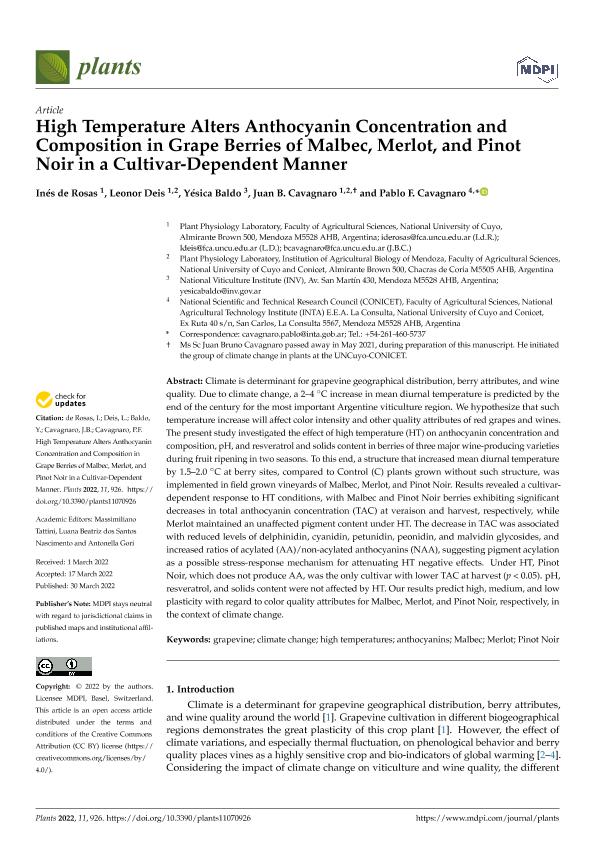Mostrar el registro sencillo del ítem
dc.contributor.author
de Rosas, María Inés

dc.contributor.author
Deis, Leonor

dc.contributor.author
Baldo, Yésica
dc.contributor.author
Cavagnaro, Juan Bruno

dc.contributor.author
Cavagnaro, Pablo Federico

dc.date.available
2023-02-15T14:02:03Z
dc.date.issued
2022-04
dc.identifier.citation
de Rosas, María Inés; Deis, Leonor; Baldo, Yésica; Cavagnaro, Juan Bruno; Cavagnaro, Pablo Federico; High Temperature Alters Anthocyanin Concentration and Composition in Grape Berries of Malbec, Merlot, and Pinot Noir in a Cultivar-Dependent Manner; MDPI; Plants; 11; 7; 4-2022; 1-16
dc.identifier.issn
2223-7747
dc.identifier.uri
http://hdl.handle.net/11336/188088
dc.description.abstract
Climate is determinant for grapevine geographical distribution, berry attributes, and wine quality. Due to climate change, a 2–4◦ C increase in mean diurnal temperature is predicted by the end of the century for the most important Argentine viticulture region. We hypothesize that such temperature increase will affect color intensity and other quality attributes of red grapes and wines. The present study investigated the effect of high temperature (HT) on anthocyanin concentration and composition, pH, and resveratrol and solids content in berries of three major wine-producing varieties during fruit ripening in two seasons. To this end, a structure that increased mean diurnal temperature by 1.5–2.0◦ C at berry sites, compared to Control (C) plants grown without such structure, was implemented in field grown vineyards of Malbec, Merlot, and Pinot Noir. Results revealed a cultivar-dependent response to HT conditions, with Malbec and Pinot Noir berries exhibiting significant decreases in total anthocyanin concentration (TAC) at veraison and harvest, respectively, while Merlot maintained an unaffected pigment content under HT. The decrease in TAC was associated with reduced levels of delphinidin, cyanidin, petunidin, peonidin, and malvidin glycosides, and increased ratios of acylated (AA)/non-acylated anthocyanins (NAA), suggesting pigment acylation as a possible stress-response mechanism for attenuating HT negative effects. Under HT, Pinot Noir, which does not produce AA, was the only cultivar with lower TAC at harvest (p < 0.05). pH, resveratrol, and solids content were not affected by HT. Our results predict high, medium, and low plasticity with regard to color quality attributes for Malbec, Merlot, and Pinot Noir, respectively, in the context of climate change.
dc.format
application/pdf
dc.language.iso
eng
dc.publisher
MDPI
dc.rights
info:eu-repo/semantics/openAccess
dc.rights.uri
https://creativecommons.org/licenses/by/2.5/ar/
dc.subject
ANTHOCYANINS
dc.subject
CLIMATE CHANGE
dc.subject
GRAPEVINE
dc.subject
HIGH TEMPERATURES
dc.subject
MALBEC
dc.subject
MERLOT
dc.subject
PINOT NOIR
dc.subject.classification
Horticultura, Viticultura

dc.subject.classification
Agricultura, Silvicultura y Pesca

dc.subject.classification
CIENCIAS AGRÍCOLAS

dc.title
High Temperature Alters Anthocyanin Concentration and Composition in Grape Berries of Malbec, Merlot, and Pinot Noir in a Cultivar-Dependent Manner
dc.type
info:eu-repo/semantics/article
dc.type
info:ar-repo/semantics/artículo
dc.type
info:eu-repo/semantics/publishedVersion
dc.date.updated
2023-02-09T15:51:06Z
dc.journal.volume
11
dc.journal.number
7
dc.journal.pagination
1-16
dc.journal.pais
Suiza

dc.journal.ciudad
Basilea
dc.description.fil
Fil: de Rosas, María Inés. Universidad Nacional de Cuyo. Facultad de Ciencias Agrarias. Departamento de Ciencias Biológicas. Cátedra de Fisiología Vegetal; Argentina. Consejo Nacional de Investigaciones Científicas y Técnicas. Centro Científico Tecnológico Conicet - Mendoza; Argentina
dc.description.fil
Fil: Deis, Leonor. Universidad Nacional de Cuyo. Facultad de Ciencias Agrarias. Departamento de Ciencias Biológicas. Cátedra de Fisiología Vegetal; Argentina. Consejo Nacional de Investigaciones Científicas y Técnicas. Centro Científico Tecnológico Conicet - Mendoza; Argentina
dc.description.fil
Fil: Baldo, Yésica. Instituto Nacional de Vitivinicultura. - Ministerio de Producción y Trabajo. Secretaria de Gobierno de Agroindustria. Instituto Nacional de Vitivinicultura; Argentina
dc.description.fil
Fil: Cavagnaro, Juan Bruno. Universidad Nacional de Cuyo. Facultad de Ciencias Agrarias. Departamento de Ciencias Biológicas. Cátedra de Fisiología Vegetal; Argentina. Consejo Nacional de Investigaciones Científicas y Técnicas. Centro Científico Tecnológico Conicet - Mendoza; Argentina
dc.description.fil
Fil: Cavagnaro, Pablo Federico. Instituto Nacional de Tecnología Agropecuaria. Centro Regional Mendoza-San Juan. Estación Experimental Agropecuaria La Consulta; Argentina. Universidad Nacional de Cuyo. Facultad de Ciencias Agrarias. Departamento de Producción Agropecuaria. Cátedra de Horticultura y Floricultura; Argentina. Consejo Nacional de Investigaciones Científicas y Técnicas. Centro Científico Tecnológico Conicet - Mendoza; Argentina
dc.journal.title
Plants
dc.relation.alternativeid
info:eu-repo/semantics/altIdentifier/url/https://www.mdpi.com/2223-7747/11/7/926
dc.relation.alternativeid
info:eu-repo/semantics/altIdentifier/doi/http://dx.doi.org/10.3390/plants11070926
Archivos asociados
